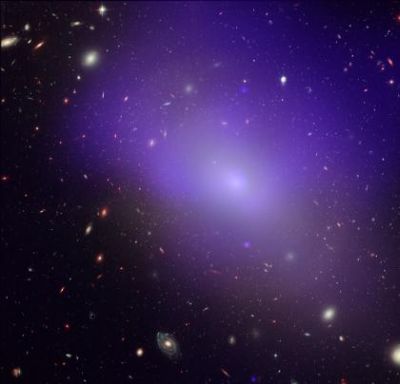18 March 2008

The Massive Galaxy NGC 1132
Credit: X-ray: NASA/CXC/Penn State/G. Garmire; Optical: NASA/ESA/STScI/M. West
NASA recently published an outstanding image of the massive elliptical galaxy NGC 1132, combining data from two of the four “Great Observatories”, the Chandra X-ray Observatory (CXO) and the Hubble Space Telescope (HST).
In this image, the bluish-purple glow is X-ray emission recorded by CXO. HST visual light image shows a giant elliptical galaxy, dwarf galaxies in its vicinity and numerous other distant galaxies in the background.
Intriguingly, astronomers have found that NGC 1132 contains an enormous amount of dark matter, a hypothetical form of invisible mysterious matter that does not emit electromagnetic radiation, and whose existence can yet be inferred only from its gravitational influence on surrounding observable objects.
The first evidence of dark matter was found by astronomer Fritz Zwicky in 1933. Zwicky discovered that the total mass of a cluster of galaxies, based on the motions of the galaxies, is much larger than the mass of the cluster’s visible material, e.g., the galaxies and clouds of gas. Modern cosmological theories show that dark matter constitutes about 90% of the total mass of the Universe.
Several theories have been put forward to explain the nature of dark matter. One explanation postulates that dark matter is composed of weakly interacting massive particles, known as WIMPs. It is also believed that faint or dark objects such as planets, dwarf stars and black holes may be significant constituents of the dark matter.
Amazingly, the amount of dark matter bound to NGC 1132 is comparable to the dark matter found in an entire group of galaxies. Also, the large amount of hot gas detected by CXO is usually observed for a group of galaxies, rather than a single galaxy.
This indicates that mighty NGC 1132 may be a “fossil group”. Fossil group systems are believed to be the end stage of the total merging of a gravitationally interacting group of galaxies. NGC 1132 is located approximately 318 million light years away, and is visible among the stars of the constellation Eridanus, the River.
The elliptical galaxies ellipsoidal in shape. Their overall yellowish hue is due to old red stars. Giant elliptical galaxies are the largest galaxies of the Universe. A giant elliptical galaxy is several trillion times more massive than the Sun. Elliptical galaxies are almost depleted in cool gas, the raw material for star formation. They can no longer produce large numbers of new stars.
Further Reading
CXO
http://chandra.harvard.edu/about/index.html
HST
http://hubblesite.org/
Elliptical Galaxies
http://seds.org/MESSIER/elli.html
Aymen Mohamed Ibrahem
Senior Astronomy Specialist